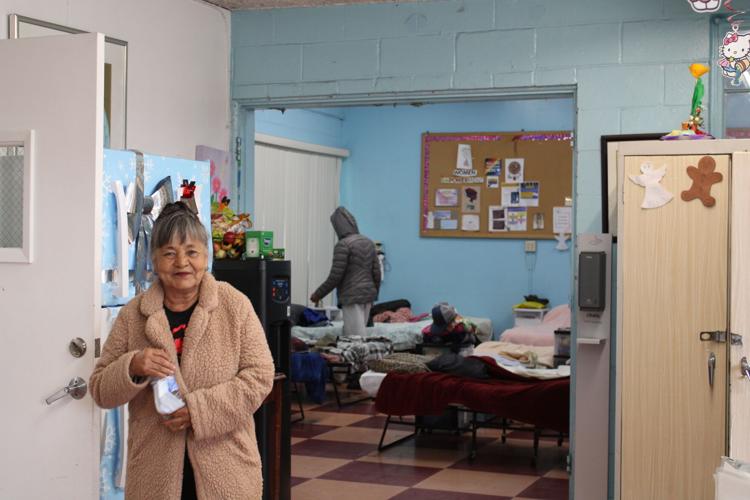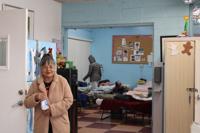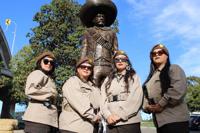
Rosa Cabrera-Salas, 56 at the Boyle Heights shelter. Photo courtesy of the Latino Homelessness Briefing
Rosa Cabrera-Salas, 56, was one of the hundreds of people working at the Los Angeles Fashion District’s Santee Alley, a historical outdoor shopping center made up of approximately 150 stores selling apparel, beauty supplies and more. With a weekly pay of only $250, she could barely afford to pay the rent for the small room she lived in. That was until 2022, when she suffered an injury, causing her to lose her job and quickly become homeless.
“I was hurt and instead of helping me, my employer at that time threatened to call immigration on me because she didn't want me to file a worker's compensation claim after she stole several months of unpaid overtime for me,” she said. “I was in my darkest hour.“
Unfortunately, that was not the first time Cabrera-Salas, who immigrated to the United States from Mexico 25 years ago, experienced homelessness. But it was the first time she ever sought and accepted assistance.
In 2015, she was homeless for a total of five months, something she kept secret. Even though at the time she volunteered at a shelter serving people food, she did not want that help for herself.
“At that time, I did not want to tell anybody. I did not want to accept help for myself,” she said. “I was ashamed of all my failings.”
Cabrera-Salas said both of the times she’s been homeless, she has passed several traumatic moments living on the streets of L.A. as an elderly person.
In 2022, as she entered a deep depression after falling into homelessness again, she knew she needed help. “I didn't even want to exist,“ she said. “The workers at the Proyecto Pastoral's Guadalupe Homeless Project saw my condition and invited me to come live here.”
She has been living at the Guadalupe Homeless Project (GHP) ever since. GHP, located in Boyle Heights, was founded by community residents in 1988 and in 2014. It's set up a women’s shelter serving 15 women over the age of 55, the only shelter for elderly women in Los Angeles. Besides housing, the organization also provides people like Cabrera-Salas meals and showers and they connect residents to resources and services, including mental health, job skills, English classes and substance prevention if needed.
One of the things that Cabrera-Salas is currently struggling with is finding a job. “I have tried to look for work but have not been able to find work because so many people discriminate against people like me because of my age and because I am not documented,” she said. “That is why the work that these organizations do is so important because for so many of us, we are rejected and discarded, but they are like a light in the dark.”
To strengthen public understanding of housing and homelessness, a list of representatives from different community, civic and government organizations and offices, such as the Los Angeles Homeless Services Authority, Proyecto Pastoral, the Alliance of Californians for Community Empowerment (ACCE) Institute and Supervisor Holly Mitchell, came together to host a Latino Homelessness Briefing earlier this month.
The briefing, which was hosted via Zoom, provided insight into the systemic nature of housing insecurity and talked about the need for culturally competent services to combat the stigma against getting help when it comes to homelessness, as well as the need to illuminate bold solutions to prevent more Latinos from falling into homelessness.
One key point that all speakers amplified was the fact that homelessness is not a personal or family failure, as many Latinos might think, but instead, it's a systemic problem that is fueled by high rent and mortgage prices, a lack of funding and unfair labor practices.

Homelessness counts continues to rise dramatically and rapidly and Latinos are among the most vulnerable populations. Photo courtesy of the Latino Homelessness Briefing
The latest homeless count in L.A. showed that homelessness continues to rise dramatically and rapidly and Latinos are among the most vulnerable populations. According to the 2023 Greater Los Angeles Homeless Count, homelessness rose by 9% on any given night in Los Angeles County to an estimated 75,518 people and a 10% rise in the City of Los Angeles to an estimated 46,260 people. When it comes to Latinos, the same data showed they make up 43% of the county’s homeless population, a substantial increment from the 2022 count.
However, Dr. Melissa Chinchilla, LAHSA commission member and lead author of “The Full Spectrum of Latinx Homelessness” report, believes the true number of Latinos that are homeless is likely far higher. “The true number of Latinos experiencing homelessness is likely much higher because official counts, such as point in time counts, do not capture folks that are couch surfing, or doubled up living in substandard housing,” Chinchilla said. “Lots of these folks are already living on the edge of homelessness and we need to pay more attention to this population.”
Doubling-up is a term that is often used to describe when two or more adults and/or families reside in the same housing unit. Closely familiar is the Latino phrase “Donde come uno, comen tres,” or “where one person eats, three eat.“
Chinchilla believes this living situation is the most common among Latinos before becoming homeless. “We've done some work using census data to estimate the number of people living double-up due to financial hardships, and we estimate that approximately 226,000 people in Los Angeles County are living double-up,” she said. “Of these individuals, a significant proportion, close to 77%, are estimated to be Latino.”
According to Chinchilla, the highest concentrations of double-up living is found in the South LA and Metro LA regions. This correlates to the LAHSA 2023 data that showed South L.A. having the second-highest number of homeless people in the region behind central Los Angeles.
Although the U.S. Department of Housing and Urban Development does not consider people living double-up as experiencing homelessness, the briefing stated the importance of local and state programs that can start recognizing that homelessness can look different in communities of
color by expanding services to include those that are doubled-up.
Chinchilla said allocating county and state dollars to prevention services is one of the ways to prevent Latinos from entering the homeless service system. “Currently, lots of folks who are experiencing double-up homelessness do not qualify for homeless service resources because they are still housed. The Latino community is very diverse and with that, there are also various challenges that folks are facing, including challenges related to immigration status but we need to think of ways to expand [housing] resources so that everyone can qualify regardless of [their] immigration status,” she said.
Raquel Roman, executive director at Proyecto Pastoral, the parent organization of GHP, said there are a lot of structural and cultural barriers for homeless Latinos when it comes to seeking assistance. Proyecto Pastoral has successfully operated two shelters with a very high housing success rate (last quarter, 69% of individuals who came to their interim housing were able to transition to permanent housing successfully) and Roman believes the culture of competency is central to their success.
“There's a stigma about receiving help among Latinos,” she said. “Language barriers and immigration status [also] interfere with Latinos accessing homeless services.”

Raquel Roman at the Proyecto Pastoral's Guadalupe Homeless Project.Photo courtesy of the Latino Homelessness Briefing
The majority of Proyecto Pastoral’s staff is bilingual or monolingual in Spanish, but Roman has seen difficulty accessing shelters or receiving mental health support in other places where documents or applications for services are only provided in English. “A lot of times rapid rehousing applications require [applicants to] provide proof of income and social security, which makes it really difficult for undocumented Latinos to seek these supports,” she said.
In addition to these structural barriers, cultural and psychological barriers also exist. “We see cultural stigma about the reliance on government assistance, and it prevents many Latinos from accessing services they're eligible for,” she said. “A lot of times there's a fear that accessing public services will result in negative repercussions; we also see a lot of misunderstanding of the systemic nature of homelessness and accessing rental assistance and mental health support is not a personal failing but a failure of our economy and housing market.”
The Alliance of Californians for Community Empowerment (ACCE) Institute, a grassroots organization that works in South L.A., has been focusing on leading campaigns that, if passed, would ultimately provide rent stabilization and lower the rate of homelessness not just within Latinos in L.A. but at the state level.
“A lot of our work is to prevent homelessness and to support tenants who are being wrongfully evicted by landlords. Our goal is to teach [Latinos] their rights so they can defend themselves, empower themselves, but not just that … we want to give them the tools so they can be organizers and leaders within their own community,” said Sergio Vargas Rozo, Los Angeles co-director at ACCE.
Latinos represent 56% of renters in LA County. Among Latino renters, 55% spend more than 30% of their income on housing, as stated by the Latino Data Hub. Vargas Rozo said high rents and housing prices are the common problems when it comes to the housing crisis in L.A. “Renters must make nearly three times the city's minimum wage to be able to afford an average month's rent of $2,500, which means that our low-income families are paying up to 75 percent of their income into rent, sometimes even more,” he said.
Vargas Rozo said one of ACCE’s current campaigns focuses on the renter’s right to counsel, for tenants to have access to a free lawyer when it comes to housing-right cases. “Our people cannot afford a lawyer right now. This is another reason why we are seeing people out on the street and doubling up. A lot of these [housing] cases are very easy to win, but you do need a lawyer.”
In addition, ACCE is also advocating for fair access, which would reduce application fees when renters are applying for housing. “Right now, it costs around $25 to $75 just to get one application in. That cost is going to add up because you're going to have to apply to a lot of different buildings. If you're lucky to get in, then you're going to have to pay the first month, deposit, and sometimes last month,” he said.
The closing of the briefing focused on the importance that media and news outlets can play when helping to be a source of information and public awareness for Latinos and the services they can have access to and keeping city and county leaders accountable to successfully address the root causes of the homelessness crisis. “Sadly, not enough people or media are talking about the systemic nature of the lack of affordable housing and the help that is available for all these tenants,” Vargas Rozo said.















(0) comments
Welcome to the discussion.
Log In
Keep it Clean. Please avoid obscene, vulgar, lewd, racist or sexually-oriented language.
PLEASE TURN OFF YOUR CAPS LOCK.
Don't Threaten. Threats of harming another person will not be tolerated.
Be Truthful. Don't knowingly lie about anyone or anything.
Be Nice. No racism, sexism or any sort of -ism that is degrading to another person.
Be Proactive. Use the 'Report' link on each comment to let us know of abusive posts.
Share with Us. We'd love to hear eyewitness accounts, the history behind an article.